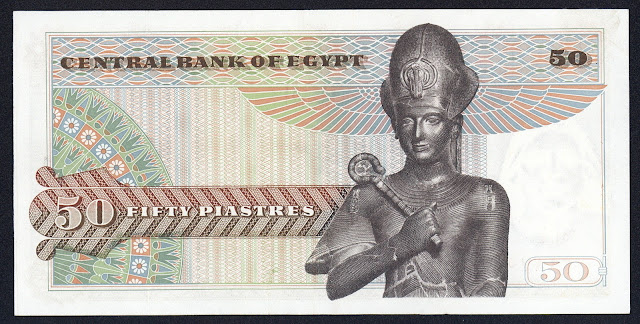Egypt banknotes 50 Piastres banknote 1970 Ramesses II
Central Bank of Egypt
Obverse: View of Al-Azhar Mosque (mosque of the most resplendent) is a mosque in Islamic Cairo in Egypt. Marble paved interior courtyard added during the Fatimid period. Two Mamluk era minarets appear in the foreground. From left to right, the double-finial minaret of Qansah al-Ghuri and the minaret of Qaytbay. Behind the dome the top of Aqbaghawiyya minaret is visible. The minaret in the far background was built by Katkhuda; value in Arabic.
Reverse: Statue of King Ramses II "Ramesses the Great" crowned with the Khepresh, the “Blue Crown of War”, and holding the Heqa-scepter in His right hand; Egyptian Museum, Torino. Bank legend at top centre.
Watermark: Archaic Egyptian scribe.
Egypt Banknotes - Egyptian Paper Money
1967-1978 Issue
Ramesses II
Ramesses II (variously transliterated as "Rameses" or "Ramses"; born c. 1303 BC; died July or August 1213 BC; reigned 1279 – 1213 BC), also known as Ramesses the Great, was the third pharaoh of the Nineteenth Dynasty of Egypt. He is often regarded as the greatest, most celebrated, and most powerful pharaoh of the Egyptian Empire. His successors and later Egyptians called him the "Great Ancestor". Ramesses II led several military expeditions into the Levant, reasserting Egyptian control over Canaan. He also led expeditions to the south, into Nubia, commemorated in inscriptions at Beit el-Wali and Gerf Hussein.
At age fourteen, Ramesses was appointed Prince Regent by his father Seti I. He is believed to have taken the throne in his late teens and is known to have ruled Egypt from 1279 BC to 1213 BC. Estimates of his age at death vary; 90 or 91 is considered most likely. Ramesses II celebrated an unprecedented 14 sed festivals (the first held after thirty years of a pharaoh's reign, and then every three years) during his reign — more than any other pharaoh. On his death, he was buried in a tomb in the Valley of the Kings; his body was later moved to a royal cache where it was discovered in 1881, and is now on display in the Cairo Museum. The early part of his reign was focused on building cities, temples and monuments. He established the city of Pi-Ramesses in the Nile Delta as his new capital and main base for his campaigns in Syria. He is also known as Ozymandias in the Greek sources, from a transliteration into Greek of a part of Ramesses' throne name, Usermaatre Setepenre, "The justice of Rê is powerful – chosen of Rê".
Al-Azhar Mosque
Al-Azhar Mosque ("mosque of the most resplendent") is a mosque in Islamic Cairo in Egypt. Al-Mu'izz li-Din Allah of the Fatimid Caliphate commissioned its construction for the newly established capital city in 970. Its name is usually thought to allude to the Islamic prophet Muhammad's daughter Fatimah, a revered figure in Islam who was given the title az-Zahrā′ ("the shining or resplendent one"). It was the first mosque established in Cairo, a city that has since gained the nickname "the City of a Thousand Minarets."
After its dedication in 972, and with the hiring by mosque authorities of 35 scholars in 989, the mosque slowly developed into what is today the second oldest continuously run university in the world after Al Karaouine in Umayyad Fes. Al-Azhar University has long been regarded as the foremost institution in the Islamic world for the study of Sunni theology and sharia, or Islamic law. The university, integrated within the mosque as part of a mosque school since its inception, was nationalized and officially designated an independent university in 1961, following the Egyptian Revolution of 1952.
Over the course of its over a millennium-long history, the mosque has been alternately neglected and highly regarded. Because it was founded as a Shiite Ismaili institution, Saladin and the Sunni Ayyubid dynasty that he founded shunned al-Azhar, removing its status as a congregational mosque and denying stipends to students and teachers at its school. These moves were reversed under the Mamluk Sultanate, under whose rule numerous expansions and renovations took place. Later rulers of Egypt showed differing degrees of deference to the mosque and provided widely varying levels of financial assistance, both to the school and to the upkeep of the mosque. Today, al-Azhar remains a deeply influential institution in Egyptian society that is highly revered in the Sunni Muslim world and a symbol of Islamic Egypt.

